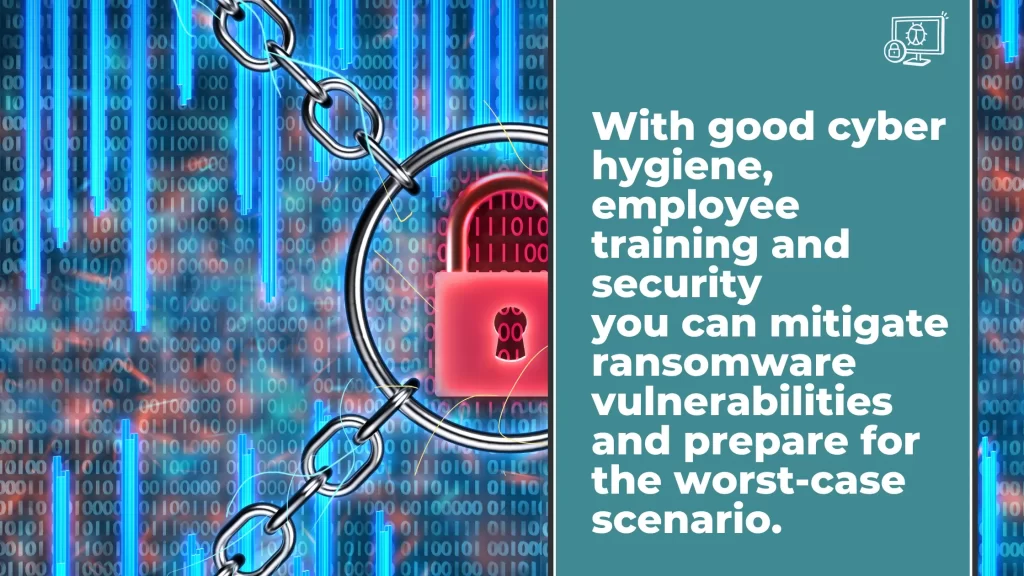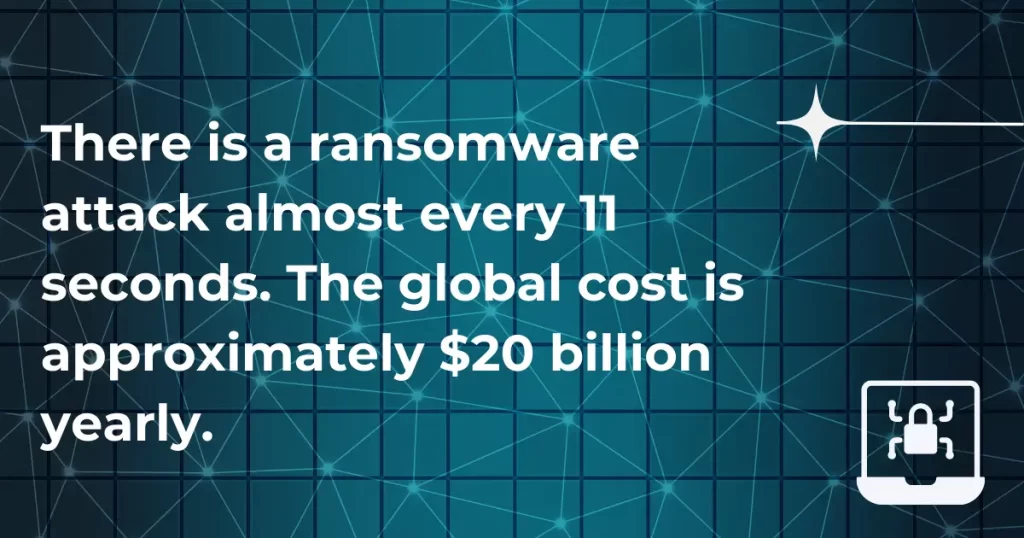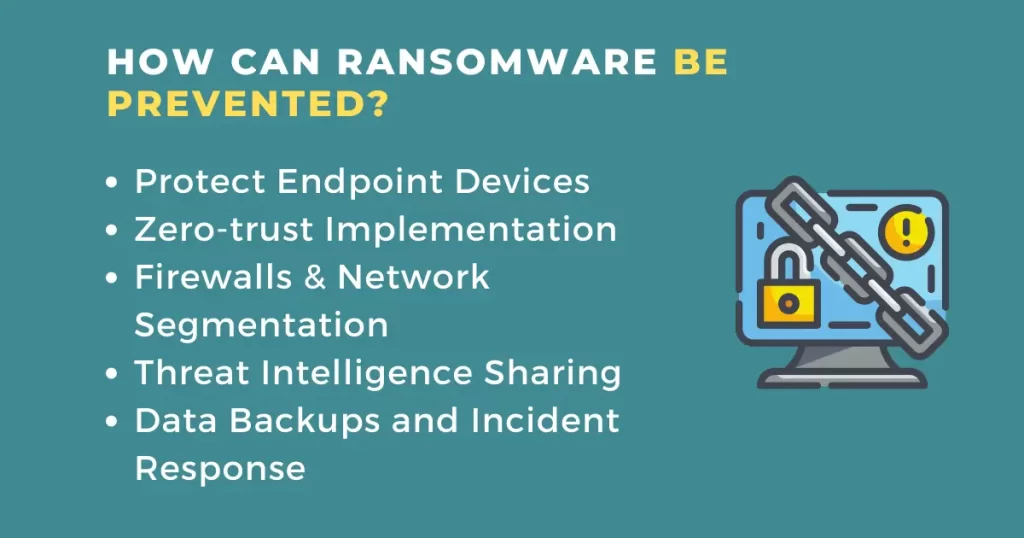
Chris Lawrence is a journalist and chief editor at Wlan Labs. He has been writing about technology for more than ten years. He writes about everything ranging from privacy to open source software. His goal is to educate readers about important topics to help make their lives easier.
Your business has a lot of important data and sensitive information that you wouldn’t want falling into the wrong hands.
However, cyber security isn’t just about keeping your data private. It’s also about ensuring you continue to have access to it yourself — but ransomware attacks could take that access from you.
Are you ready to take account of your vulnerabilities to see how you, your team, and your software can better serve your ransomware protection efforts?
In our how to stop ransomware attacks guide, you will learn more about ransomware, how to prevent it, and what to do in the case of a ransomware attack.
What Is a Ransomware Attack?
A ransomware attack is one of the most dangerous threats to cyber security and is also quite advanced. Ransomware functions through malicious software. The malware turns what was your data into encrypted data so that not even you can access it or read it.
Ransomware attackers will promise to give you a decryption key to restore data, but only if you pay the ransom. These can mean significant financial losses for you or your organization. But perhaps worse, ransomware attackers may not even decrypt your data after you pay.
How Does Ransomware Work?
For attackers to encrypt files, this is usually done by tricking users into downloading malicious software to their endpoint devices. From there, the ransomware does its work to start encrypting the files on the user’s device.
This is usually enacted through phishing or trojan horse attacks. The ransomware attacker will disguise their phishing emails or downloadable software as legitimate. But once the user has downloaded the files or opened the attachments of an email, their device is infected.

Types of Ransomware
Many ransomware variants infect personal devices and organizations differently. To prevent ransomware to the best of your abilities and understand how to act in. the case of a breach, it’s best to understand these ransomware variants.
Encryption
Encrypted files are a common tactic for ransomware attackers. You may have heard of encryption from a security standpoint. By encrypting your files, you can prevent hackers from being able to read your data and only allow authorized users to read.
But this malware designed for ransomware makes you the unauthorized user. You’ll have to get a key to access your data.
Symmetric Keys
The same key is used for malware attacks with symmetric keys for locking and unlocking the data. This form of ransomware can be enacted very quickly. This is the older method of encryption, and this form of ransomware depends on keeping this key secret.
Asymmetrical Keys
Ransomware attacks with asymmetric keys have two keys: a public one and a private one. This takes longer as the public key infects while the private one must be sent to the server. It’s also risky because if something goes wrong, all files are encrypted, including the key to decrypt. Then, there’s no hope of restoring.
Deletion
Some malware attacks not only threaten you with encryption but deletion as well. They will threaten that they will simply delete your files if you try to decrypt with a third-party tool without paying.
However, if you have unaffected backups, this won’t be too much of an additional threat.
Locking
Rather than encrypting files, these malware attacks lock you out of your device. It will lock your screen on something that makes you think the authorities are demanding money as a fine.
They may also lock keys, so it’s more difficult to escape the window. However, remember that anything like this is a scam, and you should avoid paying.
Mobile Device
Most endpoint devices targeted by ransomware attacks are PCs rather than mobile devices. However, as more organizations go remote and depend on mobile devices, attackers are now going after these devices more.
The technique for mobile devices is often locking, which is extra frustrating when you only have a frozen touchscreen. This shows how important it is to know what’s downloaded on a mobile device.

Who Is at Risk of Ransomware Attacks?
Ransomware attackers are lurking around every digital corner.
It seems human nature to hear about threats others face and think, “Well, that wouldn’t happen to me.” Insert whatever excuse you may have: my business is too small, I don’t have any data worth going after, or my spam filter will keep me safe.
You might need to reconsider if you think you’re safe from a ransomware infection. Here are the people who are most at risk.
Uninformed Users
Here’s the good news for ransomware attackers and the ugly truth for organizations with robust IT teams: 95% of breaches can be chalked up to human errors.
From phishing emails that contain malicious links and attachments to malicious files online that seem legit, tricking users is the most common tactic for spreading ransomware.
Users click on these files and malicious emails, suspecting nothing, and suddenly their device is locked, encrypted, and under ransomware.
You’re in danger if you don’t know how to identify possible malware.
Those Without Defenses
Every device has security vulnerabilities. While some devices will promote themselves as having a far smaller likelihood of being hacked, that’s not a 100% guarantee of no vulnerabilities.
If you’re not implementing your defenses against ransomware, your files could be encrypted before you realize what’s happening.
Devices with Outdated Hardware, Software, and Operating Systems
Having anti-ransomware software is a great place to start with cyber security. However, this isn’t a one-and-done solution. Software developers are constantly improving their offerings. And your device will let you know when its operating systems need to be updated.
Update reminders aren’t just annoying pop-ups. These could come with important latest security patches.
And with updates, you can take advantage of advanced machine learning to identify malware, ensuring you’re protected against novel threats. Devices that are out of date are most vulnerable.
All Users
Whatever excuse you can come up with about why ransomware attackers would never come knocking on your digital door, it’s time to accept that it’s just that — an excuse.
The truth is that everyone is vulnerable. No endpoint device is safe, from large organizations to the smallest of local businesses. Small businesses are more likely to suffer from social engineering attacks which could lead to a successful ransomware implementation.
Security professionals advise everyone to be on their guard to prevent ransomware, whether in the office or working off a remote desktop protocol.
Can Ransomware Attacks Be Stopped?
Everyone is a potential victim, but it’s not all doom and gloom. Ransomware is incredibly effective because it can prey on many users’ weaknesses. But the ransomware can be stopped when everyone from private users to large enterprises does what they can to always avoid a worst-case scenario.
From keeping potentially dangerous file types far from your download folder to implementing the right software, you can prevent a problem for you or your organization.
What Can Be Done to Prevent Ransomware Attacks?
Now that you know of the various malware strains and how hackers encrypt data, you may be getting a better idea of how you can prevent malicious software from taking hold of your files. But if you don’t know where to start, here are the top ways you can stop hackers in their tracks.
Security Awareness User Training
Good cyber hygiene is crucial to individuals and organizations alike. A common method is to undergo training on the basics of identifying potentially malicious files or malicious links. When you know what to click on, you can significantly cut back the likelihood of downloading malware.
Email Security Solutions
Malicious email attachments and phishing messages are some of the most common ways users are tricked into these schemes.
Organizations must enact stronger email security solutions to ensure only legitimate communications get through to inboxes. Solutions include filters, sender authorization, and alerts to users. If you haven’t recently thought about email security, it’s time.
Web Filtering & Isolation
Web filtering and isolation tools ensure users only surf known, trustworthy sites. Filters prevent users from visiting certain domains entirely.
This is effective but may keep people from pages they need. Isolation, on the other hand, doesn’t affect the user’s experience but puts them on secure servers, and threats are contained without access to data.
Zero-Trust Policies
What was once considered advanced attacks now seem like child’s play. Hackers are only improving and can infiltrate some of our most crucial industries. Security tools can’t possibly keep up if they depend on being explicitly instructed on what to look for.
However, you can implement zero-trust tools. These identify anything novel that hasn’t been deemed trustworthy and treat it as a potential threat. This ensures you don’t fall victim to the newest forms of attack out of sheer ignorance on the part of your software.
Deception Technology
If you want to learn more about the threat actors seeking to infiltrate your files, deception technology allows you to set up decoys.
These decoys mimic your system but isolate the attackers. This allows network administrators to observe or even collect forensic analysis they can turn over to the authorities.
Network Segmentation
Lateral movement occurs when one device is infiltrated, and the malware can then spread, encrypting or deleting information across departments. However, not every member of your team needs access to all data.
By segmenting your organization by what data users genuinely need access to, you can prevent rapid movement and keep the damage confined to one area.
Backup Files
This is less attack prevention and more damage prevention. The goal of ransomware is to hold your data from you so that you feel you need to pay the ransom to get it back.
However, if you already have an unencrypted version, the threats are greatly minimized (if not non-existent). Regularly back up what you have and keep your data backups far from others to avoid spreading ransomware.
Responding to Ransomware
In addition to prevention, it’s also best to have an incident response plan. Know what you would do to restore systems after an attack and let leaders know so that you’re all on the same page.
Isolate Infected Systems
An attack surface is what a hacker has access to encrypt. By minimizing the attack surface, you contain the damage. In the case of an attack, shut down your systems immediately, pull the plug on connections, and keep the attack contained to only what they’ve already accessed.
Identify the Kind of Attack
The solution to ransomware will vary based on the type of attack. To get the best results for restoring your data, you’ll want to identify the type of attack so your IT team can get to work.
Contact the Authorities
Getting the authorities involved benefits you and them. The authorities still want to learn more about these threats, and your ransomware attack can help. They can also collect forensic analysis to find the hackers. But while some victims pay, the authorities can help you identify the best course of action.
Should You Pay the Ransom?
Ultimately, if you’re the victim of an attack, there will always come a request for ransomware payments. But should people and organizations pay? No, and this is for two reasons:
Even after you pay, the hackers may not even provide the private key to decrypt your files, meaning you’ve wasted your money.
Most who pay become repeat victims.
Finding another solution is best if you want to avoid wasting money and take the target off your back.
Focus on Prevention
Stopping ransomware is the best way to protect data. Protective measures will keep a malware infection at bay, ensuring you don’t ever need to pay a ransom.
Work with the Authorities
If you are successfully attacked, get the authorities involved. They can help organizations recover data with their decryption tools and go after the hackers.
Get a Decryption Tool
If all else fails in your ransomware attack plan, it’s time to get a tool to decrypt data. These tools work for restoring data without paying ransom demands. You can decrypt files and get back to your routine.
What Is Security Awareness Training?
Security awareness training is a program designed to educate employees about security risks and what they can do to mitigate those risks.
Security awareness training aims to reduce the likelihood of successful attacks by increasing employee awareness of potential threats and empowering them to take action to protect themselves and their organizations.
Security awareness training covers social engineering, ransomware, password, email, and physical security.
By increasing employee knowledge of these topics, security awareness training can help to reduce the overall risk of a successful attack.
Keep Your Organization’s Data Safe — Prevent Ransomware Now
Malicious actors are out there, and they’re ready to strike. A ransomware attack is a highly effective tool for hackers to get a payment from users to decrypt their infected files and data.
But with the proper data security, you don’t have to live in fear. Follow this guide, so you’re prepared for ransomware attacks.

